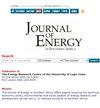微藻生物量对废煤粉热特性的影响
IF 0.6
4区 工程技术
Q4 ENERGY & FUELS
引用次数: 10
摘要
在本研究中,用不同生物量比的活微藻浆处理废煤粉,形成煤-微藻共混物。对母质样品和煤微藻混合物的近似值、极限值和热值进行了分析。在惰性条件下对母质样品和煤微藻共混物进行了热重实验。目的是研究将活微藻浆液加载到废煤上对煤的整体化学和热特性的影响。分析结果表明,微藻浆与煤的掺合有利于煤的热分解。煤-微藻共混物的氢含量和挥发物含量均高于煤。此外,微藻的存在导致在较低温度(200-400℃)下分解速度更快,残余质量分数更低。微藻浆料与废煤配伍可以提高废煤的热反应性,提高废煤的热转化率。本文章由计算机程序翻译,如有差异,请以英文原文为准。
Influences of microalgae biomass on the thermal behaviour of waste coal fines
For this study, waste coal fines were treated with live microalgae slurry at varying biomass ratios to form coal-microalgae blends. The parent samples and the coal-microalgae blends were analysed for their proximate, ultimate and calorific values. Thermogravimetric experiments were performed on the parent samples and coal-microalgae blends under inert conditions. The aim was to investigate the effects of loading live microalgae slurry onto the waste coals with respect to the overall chemical and thermal characteristics of the coal. Based on the analysed results, the blending of microalgae slurry with coal has been shown to enhance thermal decomposition of coal. Coal-microalgae blends have a higher hydrogen content and volatile matter content than coal. Moreover, the presence of microalgae results in faster rates of decomposition at lower temperatures (200–400 ºC), and lower residual mass fraction. The blending of microalgae slurries with waste coal appears to be suitable for enhancing the thermal reactivity of waste coal as well as improving the thermal conversion of waste coal.
求助全文
通过发布文献求助,成功后即可免费获取论文全文。
去求助
来源期刊

Journal of Energy in Southern Africa
ENERGY & FUELS-
CiteScore
3.00
自引率
0.00%
发文量
16
审稿时长
6 months
期刊介绍:
The journal has a regional focus on southern Africa. Manuscripts that are accepted for consideration to publish in the journal must address energy issues in southern Africa or have a clear component relevant to southern Africa, including research that was set-up or designed in the region. The southern African region is considered to be constituted by the following fifteen (15) countries: Angola, Botswana, Democratic Republic of Congo, Lesotho, Malawi, Madagascar, Mauritius, Mozambique, Namibia, Seychelles, South Africa, Swaziland, Tanzania, Zambia and Zimbabwe.
Within this broad field of energy research, topics of particular interest include energy efficiency, modelling, renewable energy, poverty, sustainable development, climate change mitigation, energy security, energy policy, energy governance, markets, technology and innovation.
 求助内容:
求助内容: 应助结果提醒方式:
应助结果提醒方式:


